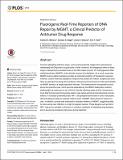Fluorogenic Real-Time Reporters of DNA Repair by MGMT, a Clinical Predictor of Antitumor Drug Response
Author(s)
Beharry, Andrew A.; Kool, Eric T.; Samson, Leona D; Nagel, Zachary D.
DownloadBeharry-2016-Fluorogenic Real-Tim.pdf (705.9Kb)
OPEN_ACCESS_POLICY
Open Access Policy
Creative Commons Attribution-Noncommercial-Share Alike
Terms of use
Metadata
Show full item recordAbstract
Common alkylating antitumor drugs, such as temozolomide, trigger their cytotoxicity by methylating the O6-position of guanosine in DNA. However, the therapeutic effect of these drugs is dampened by elevated levels of the DNA repair enzyme, O6-methylguanine DNA methyltransferase (MGMT), which directly reverses this alkylation. As a result, assessing MGMT levels in patient samples provides an important predictor of therapeutic response; however, current methods available to measure this protein are indirect, complex and slow. Here we describe the design and synthesis of fluorescent chemosensors that report directly on MGMT activity in a single step within minutes. The chemosensors incorporate a fluorophore and quencher pair, which become separated by the MGMT dealkylation reaction, yielding light-up responses of up to 55-fold, directly reflecting repair activity. Experiments show that the best-performing probe retains near-native activity at mid-nanomolar concentrations. A nuclease-protected probe, NR-1, was prepared and tested in tumor cell lysates, demonstrating an ability to evaluate relative levels of MGMT repair activity in twenty minutes. In addition, a probe was employed to evaluate inhibitors of MGMT, suggesting utility for discovering new inhibitors in a high-throughput manner. Probe designs such as that of NR-1 may prove valuable to clinicians in selection of patients for alkylating drug therapies and in assessing resistance that arises during treatment.
Date issued
2016-04Department
Massachusetts Institute of Technology. Department of Biological Engineering; Massachusetts Institute of Technology. Department of BiologyJournal
PLOS ONE
Publisher
Public Library of Science
Citation
Beharry, Andrew A., Zachary D. Nagel, Leona D. Samson, and Eric T. Kool. “Fluorogenic Real-Time Reporters of DNA Repair by MGMT, a Clinical Predictor of Antitumor Drug Response.” Edited by Robert W Sobol. PLoS ONE 11, no. 4 (April 1, 2016): e0152684.
Version: Final published version
ISSN
1932-6203